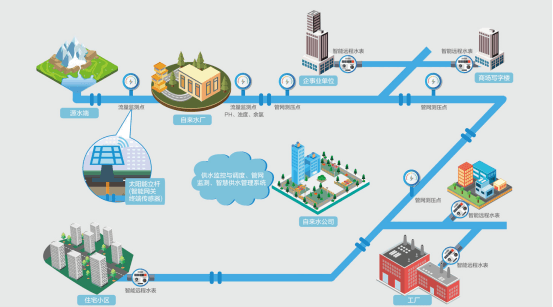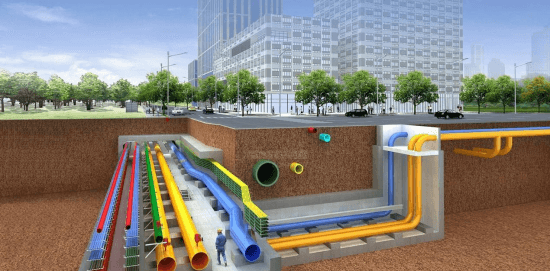On October 8, 2024, Liu Sushe, Deputy Director of the National Development and Reform Commission, held a press conference at the State Council Information Office on the implementation of a package of incremental policies to solidly promote the upward structural optimization of the economy and the sustained improvement of development trends. He stated that the total amount of various types of pipelines, such as gas, water supply and drainage, and heating, that are expected to need to be renovated in the next five years for the construction and renovation of underground pipelines is approximately 600,000 kilometers, with a total investment demand of 4 trillion yuan.

Does the pipeline industry chain sound a bit high-end?
It’s actually the invisible ‘blood vessels’ in our city – water supply, drainage, gas, and heating pipelines. These pipelines are the lifeblood of urban operation.
Why is the pipeline industry chain on fire? The reason is simple, two words: money and technology.
Money: In the next five years, we plan to invest 4 trillion yuan in urban pipeline construction.
Technology: High end technologies such as 5G, the Internet of Things, and big data are revitalizing the pipeline industry chain. Intelligent pipeline network, remote monitoring, data analysis.

Several key roles in the pipeline industry chain:
Material supplier: With the acceleration of pipeline construction, the demand for high-quality pipeline materials is also soaring. This is a big cake.
Engineering construction companies: Pipeline construction cannot be separated from these hardworking builders. They will be the direct beneficiaries of this feast.
Equipment manufacturers: The construction of intelligent pipeline networks cannot be separated from advanced equipment. Equipment manufacturer, are you ready?
Operation and maintenance company: With the intelligentization of the pipeline network, the operation and maintenance company also needs to keep up with the pace and improve its technical capabilities.
Investment Overview
Total investment scale
The construction and renovation of local pipeline networks is an important component of urban infrastructure upgrading, and the total investment demand is expected to reach 4 trillion yuan in the next five years. This massive investment scale will cover the renovation of various pipeline networks such as urban gas, water supply and drainage, and heating, with an estimated total renovation distance of 600,000 kilometers. This investment scale not only reflects the urgent need for urban infrastructure renewal, but also brings huge market opportunities to related industrial chains.
Funding sources and policy support
In terms of fund sources, Liu Sushe, deputy director of the National Development and Reform Commission, said that he would make good use of all kinds of funds, including investment within the central budget, additional treasury bond funds and extra long term special treasury bond funds. From 2023 to 2024, more than 470 billion yuan of funds have been allocated to support urban renewal projects such as the renovation of underground gas and drainage pipelines, as well as the renovation of old urban communities. In addition, the National Development and Reform Commission will issue a 100 billion yuan central budget investment plan and a list of 100 billion yuan “Two-importance” construction projects ahead of schedule this year to support local governments in accelerating preliminary work and starting construction ahead of schedule.
In terms of policy support, the government will increase its support for key urban renewal projects, prioritizing the construction of urban pipeline network safety improvement, livable renovation of old residential areas, comprehensive renovation of urban villages, and safety renovation of urban transportation facilities that involve major public safety and important livelihood guarantees. At the same time, the government encourages innovative financing models, including public-private partnership (PPP) models and infrastructure REITs, to form a sustainable renewal and transformation model guided by the government, operated by the market, and participated by the whole society.
Industry Chain Analysis
Pipeline material supplier
The large-scale investment in pipeline construction and renovation will directly drive the business growth of pipeline material suppliers. With the increasing demand for urban pipeline network renovation, the demand for high-quality pipeline materials, fittings, and related products has also risen.

Market size forecast: It is expected that by 2025, the market size of new and renovated urban water supply networks, drainage networks, gas networks, thermal networks, etc. will exceed 700 billion yuan, and pipeline material suppliers will receive significant order growth from it.
Investment trend: With the advancement of urban renewal and new urbanization construction during the 14th Five Year Plan period, pipeline material suppliers will face more market opportunities, especially in segmented markets such as plastic pipes, cast iron pipes, and concrete pipes.
Pipeline Network Design and Engineering Services
The design and engineering services of urban pipeline networks are important links in pipeline construction. With the increase of pipeline network renovation projects, the demand for professional design and engineering services will also increase.

Service demand analysis: Urban pipeline network renovation not only requires high-quality materials, but also professional design and construction plans. It is expected that the market size of high value-added services such as design consulting, engineering general contracting, and project management will significantly increase in the next five years.
Technological development trend: With the promotion and application of BIM technology and digital collaborative design platforms, pipeline design and engineering services will become more intelligent and refined, improving the technical level and service quality of the entire industry.
Intelligentization and maintenance of pipeline network
Smart pipeline network is an important development direction for future urban pipeline network construction. By introducing technologies such as the Internet of Things, big data, and cloud computing, intelligent management and maintenance of the pipeline network can be achieved.

Market size prediction: The smart pipeline network market is expected to grow at a compound annual growth rate of 12.6%, and the market size will reach 43.8 billion yuan by 2025.
Technology and Service Innovation: The construction of a smart pipeline network will promote innovation in related technologies and services, including intelligent monitoring, data analysis, predictive maintenance, etc., providing technical support for the safe and efficient operation of the pipeline network.
Policy support: A series of policy measures introduced by the national and local governments, such as the 14th Five Year Plan, provide policy and investment support for the development of smart pipeline networks, promoting the healthy and orderly development of the industry.
Types of beneficiary industries
Pipeline Building Materials Group
With the advancement of local pipeline construction and renovation, pipeline building materials groups will become the most direct beneficiaries. The provision of necessary pipeline materials by pipeline manufacturers is the material foundation for urban infrastructure construction.

Water and Environmental Engineering Company
Water and environmental engineering companies play a key role in the design, construction, and operation of pipeline network construction and renovation, and are an important link in the industrial chain.
Related equipment manufacturers
The construction and renovation of pipeline networks not only require pipeline materials, but also a large amount of related equipment, such as excavation machinery, welding equipment, testing instruments, etc. Equipment manufacturers will also benefit from it.

Various companies in the above industries will gain significant business growth and market opportunities from the total investment of 4 trillion RMB in local pipeline network construction and renovation. With the progress of the project and the gradual formation of physical workload, the performance of these companies is expected to be further improved.
This time, the government not only spent money, but also introduced a series of policies to support this project. For example, issuing investment plans in advance, prioritizing support for key urban renewal projects, and encouraging innovative financing models to attract private capital participation.

